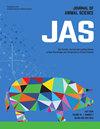Breed and trace mineral source influence the performance of beef heifers during periods of nutrient restriction and grazing forage at early vegetative stage
IF 2.7
2区 农林科学
Q1 AGRICULTURE, DAIRY & ANIMAL SCIENCE
引用次数: 0
Abstract
We evaluated the effects of breed and mineral source on heifer performance during periods of nutrient restriction and grazing. On day -7, ½ Angus × ½ Nelore (ANE) and Nelore (NE) heifers (12 heifers per breed; body weight, BW = 264 ± 35 kg; age = 15 ± 1 mo) were assigned to individual drylot pens to receive ad libitum Tifton 85 (Cynodon sp.) hay and white salt for 7 days. On day 0, within each breed, heifers were randomly assigned (2 × 2 factorial arrangement) to receive protein supplementation (0.20% of BW; dry matter, DM) added with sulfate (SUL) or hydroxychloride (HYD) sources of Cu, Mn, and Zn from day 0 to 49. From day 0 to 34, hay DM intake was restricted to 50% of the ad libitum intake recorded from day -7 to -1. On day 35, heifers were transferred to individual pastures to graze Tifton 85 forage at early vegetative stage until day 49. No effects of breed × mineral source × day and breed × mineral source were detected (P ≥ 0.11). Nelore heifers had greater (P ≤ 0.02) average daily gain (ADG) from day 0 to 35 and day 0 to 49 compared to ANE heifers. Cumulative diarrhea incidence, fecal pH and total days of diarrhea symptoms did not differ (P ≥ 0.19) between breeds. Nelore heifers had greater (P ≤ 0.05) serum concentrations of insulin-like growth factor 1 (IGF-1) from day 35 to 45 but had less (P ≤ 0.05) serum concentrations of cortisol and haptoglobin on day 42 and 45, respectively. Serum concentrations of urea N were greater (P ≤ 0.05) for NE vs. ANE heifers on days 0 and 42 and were less (P ≤ 0.05) for NE vs. ANE on days 38, 45 and 49. Heifers supplemented with HYD had (P ≤ 0.05) greater ADG from day 0 to 35, lower cumulative diarrhea incidence and percentage of heifers exhibiting ≥ 2 days of diarrhea from day 36 to 49, less serum concentrations of non-esterified fatty acids (NEFA) on day 35, and less serum concentrations of NEFA, cortisol and urea N on day 38 compared to SUL heifers. In summary, breed influenced serum concentrations of haptoglobin, cortisol, urea N, insulin and IGF-1, and the growth of beef heifers during nutrient restriction, but did not impact growth and incidence of diarrhea during periods of grazing forage at early vegetative stage. Regardless of breed, replacing sulfate with hydroxychloride sources of Cu, Mn, and Zn led to minimal reductions on serum concentrations of NEFA, cortisol and urea N, enhanced growth during nutrient restriction, and reduced diarrhea incidence during grazing of early vegetative forage.求助全文
约1分钟内获得全文
求助全文
来源期刊

Journal of animal science
农林科学-奶制品与动物科学
CiteScore
4.80
自引率
12.10%
发文量
1589
审稿时长
3 months
期刊介绍:
The Journal of Animal Science (JAS) is the premier journal for animal science and serves as the leading source of new knowledge and perspective in this area. JAS publishes more than 500 fully reviewed research articles, invited reviews, technical notes, and letters to the editor each year.
Articles published in JAS encompass a broad range of research topics in animal production and fundamental aspects of genetics, nutrition, physiology, and preparation and utilization of animal products. Articles typically report research with beef cattle, companion animals, goats, horses, pigs, and sheep; however, studies involving other farm animals, aquatic and wildlife species, and laboratory animal species that address fundamental questions related to livestock and companion animal biology will be considered for publication.
 求助内容:
求助内容: 应助结果提醒方式:
应助结果提醒方式:


